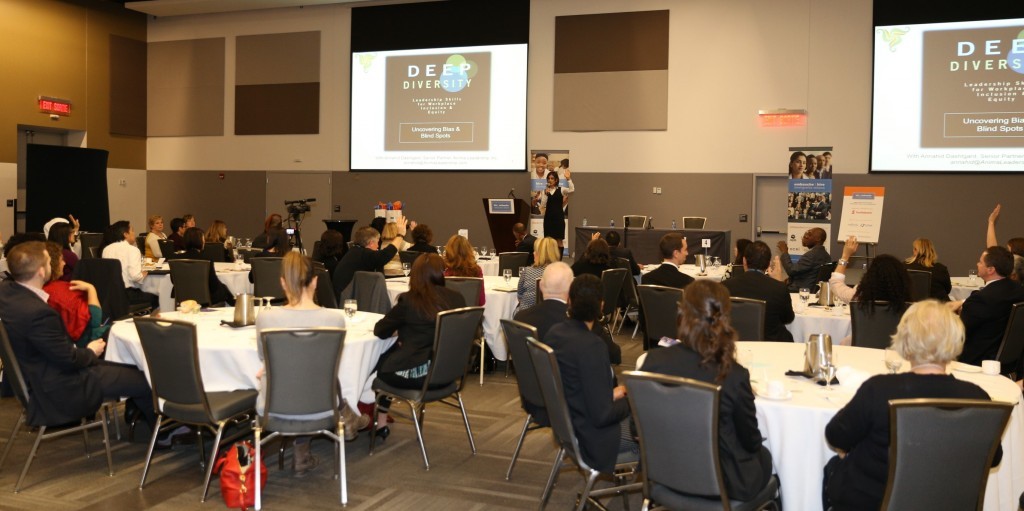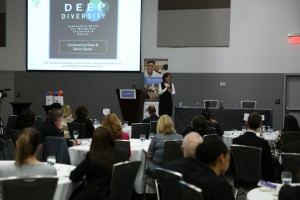
“Deep Diversity: Uncovering bias and blind spots.” Key messages from Annahid Dashtgard, Senior Partner at Anima Leadership Inc., an award-winning consulting company that offers innovative organizational change and training solutions to nurture inclusive, productive workplaces.
Society is increasingly open to discussing diversity and inclusion. The recent controversy over #oscarssowhite at the Academy Awards marks an important cultural moment.
Cultural moments are opportunities to move the public conversation beyond a discussion of why diversity and inclusion are important and focus on how society can work towards more diversity and equity.
One aspect of building inclusive workplaces is being aware of blind spots: What we don’t see often has more power to control us and shape our behaviour.
Neuroscience studies show that we may think we treat everyone the same, but something else goes on in our unconscious mind, which is dominated by emotions and instinct.
Our unconscious mind is hardwired to show empathy to those who are more like us.
Anxiety, fear and vigilance, especially around race and skin colour, are activated in the brain’s amygdala, which processes emotional reactions, as early as age three.
Because of these blind spots, leaders need to be aware of what they’re signalling unconsciously. Their verbal and non-verbal behaviour, whether intended or not, exerts a powerful force in setting the emotional tone of a group.
Dashtgard recounted her own experience as an immigrant, moving as a child from Iran to England and, finally, Alberta. In school, she stood out and was bullied. The resulting feelings of fear, anger, sadness and shame led her to develop an eating disorder.
Dashtgard shared her personal story to illustrate how different people process emotions and cope in response to being excluded.
Participants were invited to participate in a free-association exercise. Working in small groups, they listed the first words that came to mind for the following terms: Third World, Iran, immigrant.
In identifying the stereotypes and images that were associated with these words, Dashtgard noted that they comprised of more negative than positives stereotypes. These cultural stories form the norms for how we perceive people from different cultures.
They also represent patterns of thought that reflect the hidden biases hardwired into our brains. Writ large, they are reflected in an organization’s policies and procedures.
Studies show that the most effective way to fight these negative stereotypes is to consciously develop positive counter-stereotypes.
 Participants were then invited to share their personal experiences of exclusion. The stories shared by participants suggested that childhood bullying was a common experience of those who were excluded. What’s more, the trauma and wounds from exclusion can last a lifetime.
Participants were then invited to share their personal experiences of exclusion. The stories shared by participants suggested that childhood bullying was a common experience of those who were excluded. What’s more, the trauma and wounds from exclusion can last a lifetime.
Participants talked about being able to better empathize with the experiences of newcomers when they reflect on their own experiences of exclusion in its many forms.
Dashtgard pointed to studies that show higher levels of implicit bias result in:
• Employers who are less likely to interview or hire candidates with Arab or Muslim names.
• Physicians who are less likely to prescribe life-saving anti-clotting drugs to patients who are black.
• Police officers who are more likely to brandish their weapons at people of colour.
How to reduce your personal biases:
• Accept your biases and challenge your intentions.
• Show compassion to others.
• Catch yourself in the act, name the bias and analyze it.
• Notice your feelings and tackle bias consciously: Be diligent in noticing and doing something about it.
Strategies for reducing bias in your organization:
• Identify the diversity champions among senior leaders.
• Integrate diversity, inclusion and equity into strategic plans.
• Develop a robust on-boarding program for new staff.
• Introduce all employees to their rights, including policies and practices for: accommodation, a workplace free of harassment and discrimination and formal conflict resolution.
• Integrate bias-free methods for recruitment, retention, advancement.
• Collect data and measure the progress of your organization’s diversity performance against its goals.
• Educate your staff and leaders on the benefits of diversity and how bias works.
These strategies apply to all types of exclusion based, not only on race, but also on gender, sexual orientation, religion, age and physical ability.
Recommended reading: Deep Diversity: Overcoming Us vs Them by Shakil Choudhury
